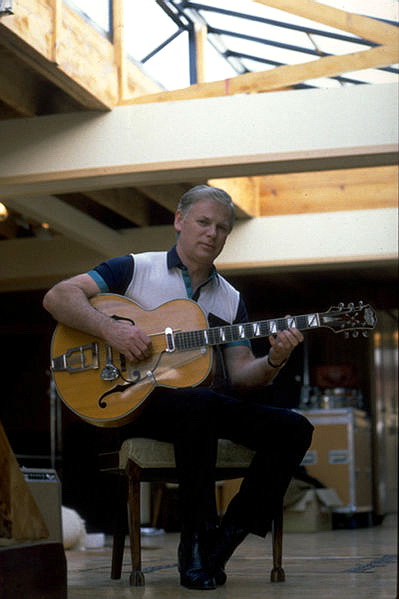
The world of music mourns the passing of Vic Flick, the revered British session guitarist whose distinctive, twangy riff became the indelible signature of the James Bond theme song. Flick, who battled Alzheimer’s disease, died on November 14 at the age of 87, leaving behind a monumental legacy that reverberates through cinematic and popular music history.
While his name might not be instantly recognized by every listener, Flick’s contributions are undeniably woven into the fabric of 20th-century sound. His work transcended a singular, iconic piece, encompassing a prolific career that saw him collaborate with an extraordinary array of musical legends, from The Beatles to Tom Jones, and from Eric Clapton to Jimmy Page. He was, as Justin Hayward of The Moody Blues noted in Flick’s memoir, “a musician’s musician,” embodying an era where the unsung session player laid the groundwork for countless chart-topping hits.
This article delves into the remarkable life and career of Vic Flick, tracing his journey from a young piano player in Surrey to the master guitarist whose instrument gave 007 his unmistakable musical identity. We explore the pivotal moments, unique techniques, and enduring collaborations that defined his foundational years and established him as one of the most significant, albeit often behind-the-scenes, figures in British music history.
1. **The Iconic James Bond Theme**
Vic Flick’s name is inextricably linked with the iconic James Bond theme, a piece of music so embedded in global culture that it has become synonymous with espionage, sophistication, and thrilling adventure. It was in 1962, for “Dr. No,” the very first James Bond film, that Flick, then just 25 years old, laid down the guitar riff that would define the spy’s musical identity for generations. For his groundbreaking contribution, he famously received a modest payment of £6, a testament to the era’s session musician economics.
Composer Monty Norman had initially conceived the theme, but it was John Barry who was brought in to arrange it, transforming Norman’s original vision. Barry’s genius, combined with Peter Hunt’s recommendation for a heavier sound, led him to Flick. Norman himself later reflected on the moment the theme truly came alive: he realized it had captured the essence of 007 after switching the main riff from a sitar to an electric guitar. “His sexiness, his mystery, his ruthlessness — it’s all there in a few notes,” Norman eloquently stated, a sentiment perfectly embodied by Flick’s raw, electric delivery.
Flick’s performance on the theme wasn’t just a recording; it was an act of creation that gave the nascent James Bond franchise a sonic identity. As he told NPR in 2012, his job was to “punch up the 007 theme — you know, give it some edge.” He modified his acoustic guitar and “really dug into the strings,” demonstrating how a normal tune would sound versus the urgent, dynamic approach he took. This distinct character became an “indelible motif in pop culture,” and though he initially received little compensation, Flick did eventually earn some royalties decades later. His memorable reflection on its lasting impact: “It’s followed me down for 50 years, so it couldn’t have been too bad.”
Read more about: Igniting the Digital Engine: 12 Rare Creations That Still Command Gaming’s Respect
2. **Early Life and Entry into Music**
Born Victor Harold Flick on May 14, 1937, in Surrey, England, his musical journey began not with a guitar, but with a piano. His father, a music teacher, ensured that young Vic started playing the piano at the tender age of seven. This early immersion in music provided a foundational understanding that would prove invaluable throughout his career, honing his ear and theoretical knowledge.
However, a pivotal shift occurred when his father, frustrated by a bad band at a dance, decided to form his own musical ensemble. His dad played piano, neighbors handled saxophone and drums, and his brother took on the bass. This left a void for Vic, a void soon filled when a neighbor provided him with a Gibson Kalamazoo, a small-bodied acoustic guitar. This instrument became his gateway to the guitar-playing world, and he embraced it with intense dedication.
Flick recounted practicing relentlessly, even “until my fingers bled,” a testament to his passion and commitment. His self-education involved deeply listening to and absorbing the styles of jazz guitar giants like Tal Farlow, Les Paul, Freddie Green, and Charlie Christian, artists who profoundly shaped his approach to the instrument. Crucially, his ability to read music opened numerous doors in the industry. Early experiments with amplification, such as strapping a tank commander’s throat mike to his guitar’s machine head and playing it through his father’s radio speaker, highlight his innovative spirit in an era before readily available guitar amplification.
Product on Amazon: 270g James Bond 007 Mini-Bars Wrapped in Iconic James Bond Film Posters Designs
Brand: Charbonnel et Walker
Binding: Grocery Product Group: Grocery
Price: 52.76 USD
Features:
1. LUXURY COLLECTION: Premium British milk chocolate bars featuring 27 unique James Bond film poster designs in a collectible gift box
2. PRESENTATION: Elegant black and Union Jack-themed packaging with gold accents, perfect for James Bond enthusiasts and collectors
3. CONTENTS: Set includes 27 individually wrapped mini milk chocolate bars, each decorated with classic 007 movie poster artwork
4. QUALITY: Crafted by renowned British chocolatier Charbonnel et Walker, known for exceptional milk chocolate craftsmanship
5. SPECIFICATIONS: Total weight of 9.52 ounces (270g), convenient mini-bar sizes perfect for sharing or collecting
Shopping on Amazon >>
Read more about: Kristen Stewart’s Style Evolution: A Glamorous Journey Through Hollywood and High Fashion
3. **The John Barry Seven and Early Success**
Vic Flick’s professional trajectory took a significant turn when he crossed paths with John Barry, an encounter that would ultimately lead to some of his most defining work. Their initial meeting occurred while Flick was performing with Bob Cort’s Skiffle, a group that shared the bill with Paul Anka on his first European tour. The John Barry Seven (JB7) accompanied Anka on this tour, providing the perfect opportunity for Barry to witness Flick’s burgeoning talent firsthand. As Flick recalled, Barry “could see I could play.”
Six months after their initial encounter, John Barry extended an invitation to Flick to join the John Barry Seven. This marked the beginning of a fruitful collaboration that would significantly elevate both their careers. By 1960, the JB7 had garnered a considerable fanbase, propelled in part by their appearances on popular television shows like “Juke Box Jury,” showcasing their energetic and innovative sound to a wider audience.
Flick’s compositional talents also shone during this period. His 1961 composition, “Zapata,” became a notable hit for the septet, further solidifying his role as a key contributor to the band’s success. This period with the John Barry Seven proved instrumental in shaping Flick’s professional experience and reputation, directly influencing Peter Hunt, the Bond films’ music editor. Hunt, impressed by the guitar-heavy music Barry composed and performed for the 1960 Adam Faith film “Beat Girl,” in which Flick’s playing was heavily featured, recommended Barry for the James Bond theme. It was this recommendation that set the stage for Flick’s most famous musical moment.
Read more about: The Cutting Room Floor Chronicles: 14 Times Prominent Actors’ Roles Were Slashed from Major Films

4. **The Legendary Gear Behind the Bond Sound**
The distinctive sound of the James Bond theme is as much a story of serendipity and ingenuity as it is of musical talent. Vic Flick famously revealed that his choice of guitar for the iconic recording was not his first preference, but rather a necessity born out of circumstance. Some “hooligans stole my Strat after a gig in North London,” he lamented, leaving him with limited options when the crucial recording session for “Dr. No” arrived.
At the time, the only other guitar Flick possessed was a 1939 English Clifford Essex Paragon Deluxe, a cello f-hole acoustic instrument manufactured in London. This guitar, a serendipitous acquisition, had been sold to him by the “wonderful guitarist” Diz Disley in 1961, during a period when Disley was experiencing financial hardship. This unexpected turn of events meant that a relatively obscure acoustic guitar, rather than a more common electric, would lend its unique character to one of cinema’s most recognizable tunes.
Flick’s technical prowess and inventive modifications were key to coaxing the famous “grungy” sound from this acoustic instrument. He fitted a DeArmond pickup near the bridge, a crucial step for amplification. To further enhance the tone and proximity to the strings, he ingeniously placed a “crushed cigarette packet underneath it.” He credited the specific recorded sound to “the plectrum I used and the guitar’s strings.” Most importantly for the sound, he used a Vox AC15 amplifier, a reliable companion on tour that, ironically, later met its demise when it “fell eight feet into a music pit and disintegrated.” The overall mysterious and powerful quality of the guitar in the recording was also due to the way it was captured: “It was picked up by the mics for the orchestra, and it gave the guitar a mysterious, powerful sound. It was a sound we created, to a certain extent, and it had a bite that they loved.”
Read more about: Igniting the Digital Engine: 12 Rare Creations That Still Command Gaming’s Respect
5. **A Prolific Session Guitarist**
Beyond the enduring fame of the James Bond theme, Vic Flick cultivated an exceptionally prolific career as a session guitarist, becoming an indispensable fixture in the vibrant British music scene of the 1960s and beyond. His ability to adapt to diverse musical styles and his reliability in the studio made him a sought-after talent. This expansive body of work, often uncredited on album sleeves, forms a significant, though largely unsung, part of his lasting legacy.
Flick frequently found himself in the company of other legendary musicians, both as a collaborator and a peer. He worked alongside esteemed guitarists like Jimmy Page and Big Jim Sullivan, exchanging ideas and contributing to countless recordings. His talent was so recognized that even Eric Clapton, a titan of the guitar world, enlisted Flick’s services for the unused theme to the 1989 Bond film “License to Kill,” a testament to his esteemed reputation among fellow musicians.
Sir George Martin, the celebrated producer often dubbed the “Fifth Beatle,” was another regular employer of Flick’s talents, repeatedly enlisting him for studio sessions. Flick became an “indispensable” presence on a remarkable list of recordings for a who’s who of pop and rock stars. His distinctive touch can be heard on tracks by Tom Jones, Cliff Richard, Dusty Springfield, Shirley Bassey, Petula Clark, and Herman’s Hermits, to name just a few. This extensive resume underscores his versatility and the profound, yet often invisible, impact he had on the soundtrack of a generation.
Read more about: The Enduring Story of a Legend: Bruce Springsteen’s Path from Asbury Park to Global Icon

6. **Collaborations with The Beatles and George Martin**
Vic Flick’s extensive session work also intertwined with the nascent careers of The Beatles, particularly through his association with producer George Martin. Flick’s distinctive Fender Stratocaster can be clearly heard underscoring the instrumental piece known as “Ringo’s Theme (This Boy)” in the Beatles’ acclaimed 1964 film, “A Hard Day’s Night.” This particular contribution highlighted his ability to weave subtle yet impactful guitar lines into orchestral arrangements, perfectly complementing the film’s narrative.
Beyond this iconic film score, Flick acknowledged performing “elsewhere in that film too,” indicating a broader involvement in the musical landscape of “A Hard Day’s Night.” He also recalled participating in some “unidentifiable sessions” with George Martin during The Beatles’ early recording days, which were “more like backing tracks than actual recordings.” The sheer volume of session work during that bustling period meant that specific details often blurred, a common experience for prolific studio musicians who moved from one project to another with swift efficiency.
Flick’s observations about The Beatles at EMI’s Abbey Road Studios offer a rare glimpse into their early dynamics. While session musicians would “come in and spread themselves all over the place” in the coffee room, The Beatles, as Flick noted, “mostly, the Beatles kept apart, sitting at the table in the corner.” This anecdote paints a picture of the emerging stars maintaining a certain distance, perhaps already sensing the immense spotlight that would soon be cast upon them, contrasting with the more communal atmosphere among the working session players.
7. **The Tom Jones Era**
Among the many iconic artists Vic Flick lent his considerable talents to, his collaborations with the legendary Welsh singer Tom Jones stand out as a significant chapter in his session career. Flick was a crucial component of Jones’s early success, playing on “all of Tom’s first hits.” This period saw Flick contribute to some of the most memorable and enduring songs of the mid-1960s, helping to shape the vibrant, brassy sound that became synonymous with Tom Jones’s powerful vocals.
For these spirited recordings, Flick primarily relied on his trusty Fender Stratocaster. He noted, “I probably used a Strat. I usually used a Strat, except on the Bond theme,” highlighting his preference for the versatile electric guitar in most of his session work. This reliance on the Strat provided the crisp, cutting guitar lines that propelled hits like “It’s Not Unusual” to global fame, adding an essential layer to Jones’s dynamic arrangements.
Flick’s involvement extended beyond just playing; his contributions were integral to the overall musical texture and energy of these tracks. The success of these collaborations underscored his status as a go-to guitarist for producers seeking a robust and precise sound. Reflecting on his choice of instrument for the Bond theme versus his later work with artists like Jones, Flick humorously mused, “Maybe I should have stayed on the Clifford Essex,” acknowledging the unique, almost fated, sound that guitar had produced.”
Read more about: Consumer Reports’ Top 7 Streaming Series: Unpacking Performance and Viewer Value for Today’s Audience

8. **Peter and Gordon and the 12-String Sound**
Vic Flick’s expansive session career extended to numerous artists who defined the British Invasion sound, including the folk-pop duo Peter and Gordon. His distinctive touch is notably heard on their 1964 hit, “A World Without Love,” a song penned by Paul McCartney. On this particular track, Flick deployed a 12-string guitar, adding a layer of rich, shimmering texture that became a hallmark of many recordings during that period.
For “A World Without Love,” Flick recalled using a Vox 12-string electric guitar. Interestingly, despite its appearance on a chart-topping record, he openly expressed his disdain for the instrument, stating, “I hated” the Vox 12-string guitar that they put on the market. This candid admission offers a glimpse into the pragmatic realities of session work, where musicians often utilized instruments not necessarily out of preference, but out of necessity or industry demand to achieve a specific sound.
Indeed, the mid-1960s marked a phase where the 12-string guitar permeated popular music, finding its way onto “everything,” as Flick observed. While its unique timbre undeniably enriched many recordings, for a working session musician like Flick, who might play the instrument for “six hours daily,” the novelty could quickly become “tiresome.” This highlights the often-unsung dedication of studio professionals who mastered and delivered diverse sounds, sometimes with instruments that tested their patience, all in service of the final track.
Product on Amazon: TV Times Tom Jones 1987 T-Shirt
Brand: TV Times
Binding: Apparel Product Group: Apparel
Price: 23.99 USD
Rating: 4.3 Total reviews: 5
Features:
1. TV and music fans rejoice! For our TV Times officially licensed clothing and accessories range, featuring a treasure trove of TV history, full of iconic actors, top music acts, sports and TV personalities spanning the past 70 years is here!
2. Officially licensed TV Times merchandise featuring the Tom Jones 1987 design.
3. Lightweight, Classic fit, Double-needle sleeve and bottom hem
Shopping on Amazon >>

9. **The Elusive Eric Clapton Collaboration**
Among the intriguing anecdotes from Vic Flick’s illustrious career is his participation in a recording session for the unused theme to the 1989 James Bond film, “License to Kill.” This session brought him together with none other than Eric Clapton, a titan of the guitar world, and the esteemed conductor and composer Michael Kamen. The very fact that Clapton, a widely recognized guitar hero, enlisted Flick’s services speaks volumes about Flick’s enduring reputation and the respect he commanded among his peers, even decades after his initial Bond theme triumph.
Flick vividly recounted the recording experience, which was video-recorded twice in an apartment overlooking the River Thames in South London. He described it as a “good, basic guitar thing” with significant impact, featuring drums, bass, percussionists, Clapton, and himself. However, despite the session’s promise and the undeniable talent assembled, the resulting two cassettes of their collaboration mysteriously “disappeared.” This vanishing act of what could have been a legendary musical pairing has rendered the recording an almost mythical entity, with Flick himself musing, “It’s something everybody’s been searching for. The two cassettes have disappeared. That would be like finding the Holy Grail.”
Following the recording, Flick was approached by representatives from the production, who expressed interest in signing him up as a featured soloist for the theme. He waited, anticipating a significant career development, only to be informed by Kamen later that the plans had changed. To Flick’s surprise and perhaps disappointment, the theme ultimately went to Gladys Knight and the Pips. The unused collaboration with Clapton remains one of the most tantalizing “what ifs” in Bond music history and a testament to Flick’s continuous relevance in the industry.
Read more about: Remembering the Stars: A Heartfelt Tribute to the Celebrities We Lost in August 2025

10. **Deeper Dive into George Martin’s Orbit**
Vic Flick’s extensive work with Sir George Martin, the legendary producer often hailed as the “Fifth Beatle,” provided unique insights into the inner workings of the British music industry. Flick knew Martin from their time at EMI’s Abbey Road Studios, and while they shared a productive professional relationship, Flick also acknowledged Martin’s occasional “attitude,” characterized by a somewhat formal, “I say, old chap, come on” demeanor. Despite this, they generally “got on well together,” a testament to Flick’s professionalism and adaptability.
A revealing moment in their relationship occurred when Flick heard Martin being interviewed on the radio. During the broadcast, Martin controversially commented on session musicians, stating they “don’t think” and “sometimes they’re just more trouble than they’re worth” if not explicitly told what to play. This statement deeply resonated with Flick and other session musicians, who felt it was an unfair generalization about their creative contributions and problem-solving abilities in the studio.
In a display of solidarity and subtle protest, Flick and his fellow musicians agreed to a collective response. During a subsequent session with Martin, they meticulously played “exactly what was written, without adding any bits,” deliberately omitting their usual improvisational flourishes and interpretive contributions. Recognizing the unusual adherence to the score, Martin eventually stopped the session and issued an apology, conceding, “Okay, stop. I shouldn’t have said that. I apologize.” This incident, a “little slap on his hand,” highlighted the mutual respect, albeit sometimes strained, between producer and player.
Flick’s observations extended to the famous inhabitants of Abbey Road as well. He noted that while session musicians would freely mingle and “spread themselves all over the place” in the coffee room, The Beatles “mostly… kept apart, sitting at the table in the corner.” This subtle detail paints a picture of the emerging stars maintaining a degree of separation, perhaps already navigating the burgeoning pressures of their fame, contrasting with the more collegial atmosphere among the seasoned studio professionals.
Ultimately, Flick recognized Martin as a “good producer” who was instrumental in “sort[ing] [The Beatles] out” and signing them to Parlophone, acknowledging his pivotal role in their historic success. These candid recollections underscore the complexities and nuanced dynamics within the recording studio during a revolutionary era of music.

11. **Encounters with James Bond Actors**
Despite his profound and indelible musical contribution to the James Bond franchise, Vic Flick’s direct interactions with the actors portraying 007 were surprisingly limited. For the groundbreaking “Dr. No” recording in 1962, the original Bond, Sean Connery, made only one appearance in the studio. Flick recalled Connery as a “very quiet” presence, who “sat in the corner of the control room.” Their paths simply did not meaningfully cross, and Flick candidly stated, “I never got to know him,” a common reality for many session musicians who contribute behind the scenes to cinematic magic.
However, Flick did have a more personal, albeit casual, encounter with a later Bond actor, Timothy Dalton, who held the role from 1987 to 1989. Flick mentioned, “I once had a few beers with Timothy Dalton.” This interaction occurred in 1989, coinciding with Flick’s participation in the unutilized music for the film “License to Kill,” during which Dalton was the incumbent Bond. While not a deep friendship, it marked a more direct, social connection with a face of the franchise.
These limited encounters underscore the distinct roles within the film production process. While Flick’s guitar provided the iconic sonic identity that would forever define James Bond, his work was largely concentrated in the studio, a separate sphere from the on-screen performances. His recollections offer a rare, understated glimpse into the practical distance between the musicians crafting the soundtrack and the stars embodying the characters, even when their legacies are so inextricably linked.
Read more about: Feeling Alone? You’re Not! Here Are 10 Underrated TV Shows You Absolutely Need to Binge ASAP
12. **Beyond Bond: A Kaleidoscope of Collaborations**
Vic Flick’s career was a vibrant tapestry woven with collaborations across the spectrum of British popular music, far beyond the confines of the James Bond universe. His versatility made him an indispensable asset for an astonishing array of artists who would go on to define generations. He truly was, as noted in his memoir by Justin Hayward of The Moody Blues, “a musician’s musician.”
Among his many significant associations was his work with Cliff Richard, a pre-eminent figure in British rock and roll. Flick’s connection with Richard predated their studio collaborations; he “knew Cliff before I recorded with him,” from their time performing at Butlins Holiday Camp in Clacton. Flick recalled Richard with “a little band in the Rock and Calypso Ballroom,” charming audiences by the swimming pool. This early acquaintance blossomed into studio work, further demonstrating Flick’s ubiquitous presence in the burgeoning pop scene.
Flick also played a foundational role in the career of Engelbert Humperdinck. He was part of The John Barry Seven when Humperdinck, then known as Jerry Dorsey, toured with them. When Dorsey’s manager envisioned a star, suggesting a name change, Flick was there for the re-recording of Humperdinck’s “first five hits.” This period showcases Flick’s ability to contribute significantly to an artist’s formative sound, adapting his playing to complement diverse vocal styles and musical arrangements.
His impressive discography extends to an even broader roster of legends, solidifying his status as a behind-the-scenes architect of numerous hits. Flick’s distinctive guitar work graced recordings for iconic singers such as Dusty Springfield, known for her soulful delivery, and Shirley Bassey, whose powerful vocals he also accompanied on Bond themes like “Goldfinger.” He further contributed to the sounds of Petula Clark, a transatlantic pop sensation, and Nancy Sinatra, adding his expert touch to their chart-topping tracks. Even bands like Herman’s Hermits, synonymous with the upbeat Merseybeat sound, benefited from Flick’s studio prowess, underscoring his remarkable adaptability across genres and artist personalities.
13. **A Guitarman’s Tools and Transitions**
Throughout his long and storied career, Vic Flick held a pragmatic philosophy regarding his instruments, viewing them primarily as “tools” of his trade. This practical perspective allowed him to manage his impressive collection without excessive sentimentality, a common trait among working session musicians. When asked about selling guitars, he would directly respond, “They’re tools,” acknowledging that while one might “get attached to them,” ultimately, they served a functional purpose in his livelihood. This approach stands in contrast to the often-romanticized view of musicians and their cherished instruments.
This practical outlook was famously highlighted when Flick appeared on the reality television show “Pawn Stars,” where he sold a Fender Stratocaster. The hosts were, as he recounted, “very impressed,” largely due to the esteemed list of artists he had accompanied with that particular instrument. He noted, “I got quite a bit of money for it because of the people I accompanied on it, like Tom [Jones], Petula Clark, and Nancy Sinatra,” demonstrating how the history and provenance of a working musician’s tool could significantly enhance its value.
His most iconic instrument, the 1939 English Clifford Essex Paragon Deluxe guitar responsible for the original Bond theme, also eventually found its way to auction. Flick, ever practical, stated simply, “It paid its way.” This willingness to part with even his most historically significant guitar underscores his perspective that instruments were investments in his career, designed to be used, generate income, and, when their time came, transition to new hands or purposes. His arsenal also included “about three Strats, a Gibson Les Paul, and an L-7C,” which he later had electrified, along with a “nice guitar,” a Martin D-28, most of which he eventually sold.
Product on Amazon: James Bond 007 for Woman III
Brand: James Bond
Binding: Health and Beauty Product Group: Beauty
Price: 21.95 USD
Rating: 3.6 Total reviews: 7
Item Form: Liquid
Item Volume: 50 Milliliters
Scent: Oriental
Special Feature: Travel Size
Features:
1. Value for money
2. Good product with excellent quality
3. Easy to use
Shopping on Amazon >>

14. **Legacy, Mentorship, and the Final Note**
In 2013, Vic Flick’s immense and often unsung contributions to the world of guitar were formally recognized when he received a Lifetime Achievement Award from the National Guitar Museum. This honor, which cited his “contribution to the history of the guitar,” served as a profound testament to a career that, while perhaps best known for a single iconic riff, was built on decades of unparalleled musicianship, versatility, and dedication. A spokesperson for the museum encapsulated the sentiment, stating, “We have been proud of our association with him. He will be missed.”
Beyond his recorded legacy, Flick also offered invaluable advice to aspiring guitarists, emphasizing a fundamental principle: “Don’t forget to make every note music.” He echoed the sentiments of jazz guitarist Jim Hall, who, observing a trend in modern playing, remarked, “I don’t know what’s happening to the guitar world. Some of these guys sound like there’s a lot of notes looking for a tune.” Flick’s counsel highlighted the importance of melodic intent and musicality over mere technical display, encouraging future generations to prioritize expression and artistry.
Perhaps one of the most poignant testaments to his influence came from Justin Hayward of The Moody Blues. Flick recounted an encounter on a television show where Hayward approached him, saying, “Can I shake your hand? If it weren’t for you, I wouldn’t be here now.” A bandmate later clarified, revealing that Hayward had seen Flick on television numerous times and declared, “‘I’ve got to do what Vic’s doing.’” This anecdote beautifully illustrates Flick’s often-unseen impact, inspiring a generation of musicians through his televised performances, and solidifying his role not just as a session legend, but as a quiet mentor to future stars.
Read more about: John Burton, California’s Liberal Warrior: An In-Depth Look at a Political Boss’s Enduring Legacy
Vic Flick’s passing at 87 marks the end of an era, but his influence continues to reverberate through the history of music. From the urgent, twangy notes of the James Bond theme that launched a global phenomenon to the countless uncredited licks on chart-topping hits, Flick was a cornerstone of the British music scene. His legacy is not merely in the indelible sounds he created, but in the inspiration he provided, the professionalism he embodied, and the quiet mastery he brought to every single note. He leaves behind a profound and multifaceted musical footprint, ensuring that his guitar’s voice will continue to resonate for generations to come.









